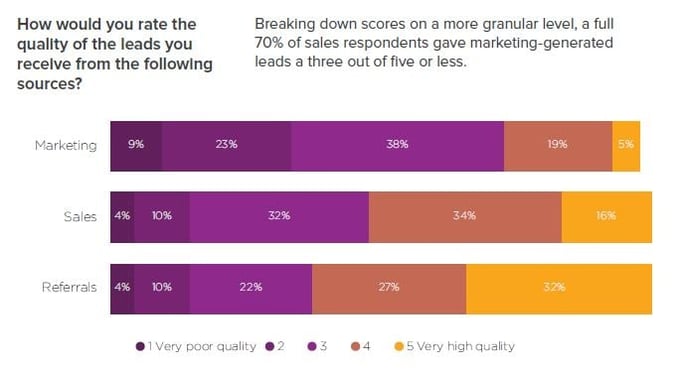
In marketing, as elsewhere, few would deny that underperforming employees should be dealt with decisively: usually through remediation but, in worse cases, termination.
The same should be said of underperforming marketing tactics. When it comes to how to market your business, there aren’t enough resources to spend on all but the best methods.
But how do you figure out what’s best? After all, marketing attribution—determining how much revenue each marketing tactic generates—is one of marketers’ most common challenges. But let’s not confuse difficulty with impossibility: you can judge marketing performance the same as any other aspect of business. You’re moving in the right direction if you’re:
- Reducing costs
- Expediting processes
- Eliminating redundancy
- Allocating resources where they’re most productive
We take a look at some data from HubSpot’s State of Inbound 2016 to determine which marketing methods, processes, and channels are top performers and which ones should get the axe.
Reducing Costs: Social Media and Email Outpace Outbound Methods
Social media and email are both low-cost marketing channels with the potential for remarkable reach. Both allow companies to respond quickly with flexibility in their content and voice. In other words, they cater to a market that appreciates responsiveness as well as a touch of personal connection.
While you could use these methods without any budget outlays, it should be noted that a little spending can extend your mileage by a lot. The best social media campaigns make good use of ads, while email marketing benefits greatly from automation software and CRM technology (more on that in a bit).
Ultimately, however, the biggest investment to be made for both is in time—time spent on training, getting a feel for the market, and fine-tuning the messages that go out to your brand’s contacts.
On the other hand, so-called outbound practices—paid advertising in traditional channels, such as trimedia and outdoor ads—are broadly considered an overrated marketing tactic. This view is held even by a significant fraction of companies that consider such methods their primary approach to marketing.

Data and figures taken from the State of Inbound 2016
Expediting Processes: The Need for CRM Technology
The right CRM software can save sales teams a lot of valuable hours. Unfortunately for most sales managers and executives, however, many sales teams appear slow to embrace such technology. Manual data entry and low usage were first and third on their list of CRM challenges. Oddly enough, coming to grips with the tool didn’t seem to be the issue, as few respondents across the board considered the tools too complicated to use.

It could be that lack of integration with other tools—another often-cited problem—discouraged use of CRM technology. Companies looking to expedite their CRM processes in specific or sales processes in general would do well to look for CRM tools that mesh well with their other tools or are integrated into comprehensive program suites that suit their needs. Anything that effectively minimises manual data entry would also, naturally, be a preeminent choice.
Eliminating Redundancy: Content Strategies and Marketing-Sales Alignment
The larger a marketing team grows, the more easy it might be for redundancy and inefficiency to creep into its processes. Without a centralised content strategy, you might end up with blog writers, web copywriters, and social media managers all doing their own thing—a lot of content produced, none of it distributed widely.
A centralised content strategy shouldn’t just align all your content creators, though; it should also make their jobs easier. Balance original content production with content curation, which can be made much simpler with sites like Paper.li or Buffer.
Another way to eliminate redundancy is by getting sales and marketing teams to work more closely together. When aligned well with each other, marketing and sales teams can provide each other with valuable support. A sales team can provide more relevant buyer information to help refine marketing strategies, while a marketing team would be able to provide better qualified leads—a significant boost, considering many sales teams consider leads sourced from marketing to be a subpar in most cases.
In this way, your sales team spends less time drawing up leads of its own, while your marketing team’s buyer research is greatly expedited. Improving employee engagement on both sides ensures none of these teams’ efforts go to waste.

Allocating Resources: Referral Networks
While marketing-sourced leads were generally considered poor, leads from referrals scored well. Unsurprising, given that customers are more likely to trust a peer than a stranger or salesperson.
If you’re considering how to increase sales, then it only makes sense to gather as many referrals as possible. Allocating resources to build a referral network, or cultivate promoters and brand ambassadors from your most loyal—or, in inbound terms, delighted—customers. And with options like social media and automated or segmented email, such engagements need not be costly at all.
It also pays to consider solutions beyond your own staff and offices. Strategic partnerships and outsourcing are both good options for marketing teams to maximise their limited time and resources. Both methods allow you to cover your weaknesses while maximizing your strengths. As a bonus, outsourcing to the Philippines or similar developing countries allows you to reduce your costs as well.
You can learn more about the current state of marketing and sales by downloading the full State of Inbound 2016 report. Or, if you’d like a deeper discussion on outsourcing marketing, don’t hesitate to get in touch.




Comments